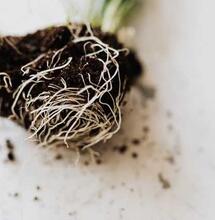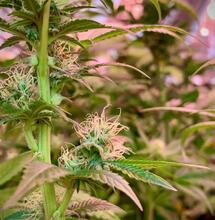All About Calcium

Plants need calcium to grow. It helps maintain a chemical balance in your soil and improves water absorption. Calcium also plays a critical role in removing carbohydrates, neutralising cell acids and aiding enzyme activity. Calcium is an essential element of cell walls development.
Most soils contain more than enough calcium in the form of calcium carbonate. Your plants also receive calcium from water and fertiliser and feed if you are growing indoors. It will depend on whether you live in a "hard water" area or a "soft water" area as to the amount of calcium your plants receive.
Calcium deficiency is caused when there is not enough soluble calcium for the plant to take up. As calcium is fixed within the plant, the effects on any new growth will be seen once levels deplete. Leaf burn and discolouration are most common. You may notice flowers and buds failing to bloom/open in the early bloom phase. You can also experience twisted and bent leaves, white streaks and other abnormalities. In more mature plants, you may see some signs of rot.
Calcium uptake is directly related to the plant's transpiration rate. A calcium deficiency does not necessarily mean that you have not given your p[lant enough calcium. The plant may not be able to take it up. The most common cause of this is stress in your grow room environments, such as high humidity or poor ventilation, which can restrict the plant's transpiration and, therefore, calcium absorption. Excessive potassium or magnesium can also negatively affect calcium uptake, as can an acidic pH because calcium is alkaline.
Check the grow room for humidity levels and adequate ventilation to correct a calcium deficiency. Likewise, look at your soil pH. Calcium is absorbed best when the pH is between 6.2-6.5. Be sure to check that you are not adding too much magnesium or potassium. Also, check the water you are using.
Hard water contains more traces of chalk and limestone and, therefore, calcium. You can now buy feeds tailored for either hard or soft water areas and compensate for those levels. Firstly, flush your plants with distilled or RO water to remove any salts that may be reducing uptake. A calcium nitrate supplement used alongside your feed can also help correct a calcium deficiency caused by uptake issues.
Remember that calcium nitrate contains nitrogen, so keep your eye on your nitrogen levels when using it. Cal-Mag formulas are paired together because calcium and magnesium deficiencies usually occur together. You should begin to see your crop recover within a week. Old leaves affected will not recover, but new growth should be healthier.
Excessive amounts of calcium can stunt growth and affect the uptake of magnesium and phosphorous. If this happens, you will see signs of deficiency from the plant not receiving adequate amounts of these nutrients, making it very difficult to identify calcium as the problem.
Flush with distilled or reverse osmosis water for 1-2 days to treat a calcium build-up. If you use a system with narrow tubes, drippers, sprayers, etc. These should be thoroughly cleaned. When this is done, flush again with clean water. You can now adjust your pH and nutrient levels to the required levels. When it gets to above 5.0, you will have eliminated all acids.



.png)





